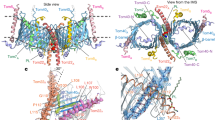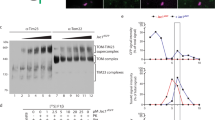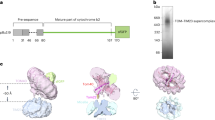Abstract
Mitochondria contain the translocator of the outer mitochondrial membrane (TOM) for protein entry into the organelle, and its subunit Tom40 forms a protein-conducting channel. Here we report the role of Tom40 in protein translocation across the membrane. The site-specific photocrosslinking experiment revealed that translocating unfolded or loosely folded precursor segments of up to 90 residues can be associated with Tom40. Purified Tom40 bound to non-native proteins and suppressed their aggregation when they are prone to aggregate. A denatured protein bound to the Tom40 channel blocked the protein import into mitochondria. These results indicate that, in contrast to the nonstick tunnel of the ribosome for polypeptide exit, the Tom40 channel offers an optimized environment to translocating non-native precursor proteins by preventing their aggregation.
This is a preview of subscription content, access via your institution
Access options
Subscribe to this journal
Receive 12 print issues and online access
$189.00 per year
only $15.75 per issue
Buy this article
- Purchase on Springer Link
- Instant access to full article PDF
Prices may be subject to local taxes which are calculated during checkout





Similar content being viewed by others
References
Schatz, G. & Dobberstein, N. Common principles of protein translocation across membranes. Science 271, 1519–1526 (1996).
Simon, S.M. & Blobel, G. A protein-conducting channel in the endoplasmic reticulum. Cell 65, 371–380 (1991).
Matlack, K.E., Motes, W. & Rapoport, T.A. Protein translocation: tunnel vision. Cell 92, 381–390 (1998).
Meyer, T.H. et al. The bacterial SecY/E translocation complex forms channel-like structures similar to those of the eukaryotic Sec61p complex. J. Mol. Biol. 285, 1789–1800 (1999).
Hanein, D. et al. Oligomeric rings of the Sec61p complex induced by ligands required for protein translocation. Cell 87, 721–732 (1996).
Künkele, K-P. et al. The protein translocation channel of the outer membrane of mitochondria. Cell 93, 1009–1019 (1998).
Ungermann, C., Neupert, W. & Cyr, D.M. The role of Hsp70 in conferring unidirectionality of protein translocation into mitochondria. Science 266, 1250–1253 (1994).
Nissen, P., Hansem, J., Ban, N., Moore, P.B. & Steitz, T.A. The structural basis of ribosome activity in peptide bond synthesis. Science 289, 920–930 (2000).
Neupert, W. Protein import into mitochondria. Annu. Rev. Biochem. 66, 863–917 (1997).
Pfanner, N. & Geissler, A. Versatility of the mitochondrial protein import machinery. Nat. Rev. Mol. Cell. Biol. 2, 339–349 (2001).
Endo, T., Yamamoto, H. & Esaki, M. Functional cooperation and separation of translocators in protein import into mitochondria, the double-membrane bounded organelles. J. Cell Sci. 116, 3259–3267 (2003).
Endo, T. & Kohda, D. Functions of outer membrane receptors in mitochondrial protein import. Biochim. Biophys. Acta 1592, 3–14 (2002).
Eilers, M. & Schatz, G. Binding of a specific ligand inhibits import of a purified precursor protein into mitochondria. Nature 322, 228–232 (1986).
Hill, K. et al. Tom40 forms a hydrophilic channel of the mitochondrial import pore for preproteins. Nature 395, 516–521 (1998).
Gordon, D.M., Amutha, B. & Pain, D. Self-association and precursor protein binding of Saccharomyces cerevisiae Tom40p, the core component of the protein translocation channel of the mitochondrial outer membrane. Biochem. J. 356, 207–215 (2001).
Stan, T. et al. Recognition of preproteins by the isolated TOM complex of mitochondria. EMBO J. 19, 4895–4902 (2000).
Brunner, J. Use of photocrosslinkers in cell biology. Trends Cell Biol. 6, 154–157 (1996).
Kanamori, T. et al. Probing the environment along the protein import pathways in yeast mitochondria by site-specific photocrosslinking. Proc. Natl. Acad. Sci. USA 94, 485–490 (1997).
Esaki, M., Kanamori, T., Nishikawa, S. & Endo, T. Two distinct mechanisms drive protein translocation across the mitochondrial outer membrane in the late step of the cytochrome b2 import pathway. Proc. Natl. Acad. Sci. USA 96, 11770–11775 (1999).
Glick, B.S., Wachter, C., Reid, G.A. & Schatz, G. Import of cytochrome b2 to the mitochondrial intermembrane space: the tightly folded heme-binding domain makes import dependent upon matrix ATP. Protein Sci. 2, 1901–1917 (1993).
Xia, Z.-X. & Mathews, F.S. Molecular structure of flavocytochrome b2 at 2.4 Å resolution. J. Mol. Biol. 212, 837–863 (1990).
Leonhard, K., Stiegler, A., Neupert, W. & Langer, T. Chaperone-like activity of the AAA domain of the yeast Yme1 AAA protease. Nature 398, 348–351 (1999).
Siegert, R., Leroux, M.R., Scheufler, C., Hartl, F.U. & Moarefi, I. Structure of the molecular chaperone prefoldin: unique interaction of multiple coiled coil tentacles with unfolded proteins. Cell 103, 621–632 (2000).
Neupert, W. & Brunner, M. The protein import motor of mitochondria. Nat. Rev. Mol. Cell Biol. 3, 555–565 (2002).
Matouschek, A. et al. Active unfolding of precursor proteins during mitochondrial protein import. EMBO J. 16, 6727–6736 (1997).
Gaume, B. et al. Unfolding of preproteins upon import into mitochondria. EMBO J. 17, 6497–6507 (1998).
Mayer, A., Neupert, W. & Lill, R. Mitochondrial protein import: reversible binding of the presequence at the trans side of the outer membrane drives partial translocation and unfolding. Cell 80 127–137 (1995).
Kanamori, T. et al. Uncoupling of transfer of the presequence and unfolding of the mature domain in precursor translocation across the mitochondrial outer membrane. Proc. Natl. Acad. Sci. USA 96, 3634–3639 (1999).
Voos, W. & Pfanner, N. The role of chaperone proteins in the import and assembly of proteins in mitochondria and chloroplasts. in Molecular Chaperones in the Cell (ed. Lund, P.) 61–89 (Oxford Univ. Press, Oxford, 2001).
Ahting, U. et al. Tom40, the pore-forming component of the protein-conducting TOM channel in the outer membrane of mitochondria. J. Cell Biol. 153, 1151–1160 (2001).
Koehler, C.M., Merchant, S. & Schatz, G. How membrane proteins travel across the mitochondrial intermembrane space. Trends Biochem. Sci. 24, 428–432 (1999).
Bauer, M.F., Hofmann, S., Neupert, W. & Brunner, M. Protein translocation into mitochondria: the role of TIM complex. Trends Cell Biol. 10, 25–31 (2000).
Kunkel, T.A., Roberts, J.D. & Zakour, R.A. Rapid and efficient site-specific mutagenesis without phenotypic selection. Methods Enzymol. 154, 367–382 (1987).
Nishikawa, S., Fewell, S.W., Kato, Y., Brodsky, J.L. & Endo, T. Molecular chaperones in the yeast endoplasmic reticulum maintain the solubility of proteins for retrotranslocation and degradation. J. Cell Biol. 153, 1061–1069 (2001).
Endo, T., Mitsui, S. & Roise, D. Mitochondrial presequences can induce aggregation of unfolded proteins. FEBS Lett. 359, 93–96 (1995).
Deshaies, R.J. & Scheckman, R. SEC62 encodes a putative membrane protein required for protein translocation into the yeast endoplasmic reticulum. J. Cell Biol. 109, 2653–2664 (1989).
Acknowledgements
We acknowledge support of this work by Grants-in-aid for Scientific Research from the Japan Ministry of Education, Culture, Sports Science and Technology (MEXT), a grant from Japan Science and Technology Agency (T.E.) and a Grant for Joint Research Project in Korea (I.S.). We thank T. Hohsaka and M. Sisido for the advice on charging of BPA to suppressor tRNA, and members of the Endo laboratory for discussions and comments. M.E. is a Japan Society for the Promotion of Science (JSPS) Research Fellow.
Author information
Authors and Affiliations
Corresponding author
Ethics declarations
Competing interests
The authors declare no competing financial interests.
Rights and permissions
About this article
Cite this article
Esaki, M., Kanamori, T., Nishikawa, Si. et al. Tom40 protein import channel binds to non-native proteins and prevents their aggregation. Nat Struct Mol Biol 10, 988–994 (2003). https://doi.org/10.1038/nsb1008
Received:
Accepted:
Published:
Issue Date:
DOI: https://doi.org/10.1038/nsb1008
This article is cited by
-
Mitochondrial import and the twin-pore translocase
Nature Reviews Molecular Cell Biology (2004)
-
Tom40: more than just a channel
Nature Structural & Molecular Biology (2003)



